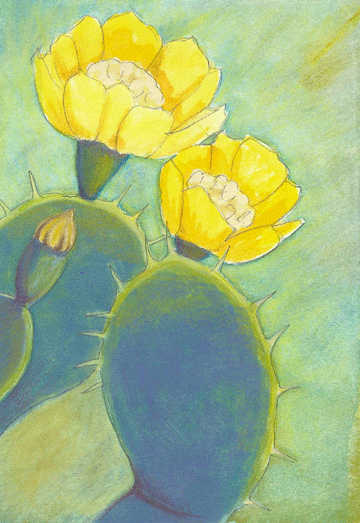
Volume XVII, Issue 26 # June 25 - July 1, 2009 |
 |
 |
Earth Journal by Gary Pendleton
 June’s Prickly Redemption
June’s Prickly Redemption
For a few weeks, the prickly pear produces flowers that redefine yellow
A prickly pear cactus grows on the south side of our house, at the foundation. The spot is under the eaves, so the soil is dry, and it is backed by a masonry wall that reflects and intensifies the heat. Prickly pears do well in places that are warm and well drained. This is such an ideal spot that the cactus keeps growing and getting in the way.
Having a cactus that gets in the way can be a problem when it’s time to paint or do home maintenance. It is not easy to weed around a big cactus; the spines easily pierce leather workgloves. If you brush against it, you might not know it at first; soon enough you will. The spines are numerous and small enough to be practically invisible, but you sure can feel them. It is not easy to prune a cactus, though I have done it. Figuring out what to do with the trimmings is the biggest challenge.
For a couple of weeks in June, the Opuntia redeems its prickly self by producing flowers that redefine the meaning of yellow.
Our cactus was probably planted many years ago by one of the previous owners of our 90-year-old house. I assume that it is a garden variety of the genus Opuntia that grows wild in the southwest.
Opuntia humifusa is low-growing and sprawling, whereas its robust western cousin stands up tall. The Chesapeake watershed has its own species of prickly pear, flourishing primarily on the coastal plain in well-drained soils.
I rarely see them growing wild but a few years ago, sandal clad, I nearly stepped on one that was in a grassy, unshaded, sandy bit of soil a few yards from the edge of the Patuxent. Last weekend at Assateague, south of Ocean City, I spotted one growing in the brush beneath the dunes.
The color of the flowers is such a super-saturated bright yellow that it is challenging to capture an accurate representation in photos or paintings. Other species of cactus have flowers that share Opuntia’s intense and pure coloration, though in different hues such as orange or red.
Bees pollinate the prickly pear flowers, which then produce a somewhat pear-shaped maroon fruit. The pears are armed with tiny spines, so it is best to take care when picking. Inside is a pleasant-tasting purple, gelatinous goo that is good for making jelly, syrup or candy. I like to cook, and my plant produces a bumper crop, but I have never tried to use the fruit. Any takers?
|
Scientific name: Opuntia humifusa What to look for: A low-growing sprawling cactus with green pads, brilliant yellow flowers or maroon fruit. Where to look: Places that are sunny and well drained; especially sloping ground with a southern exposure or very sandy soil. Places to visit: Though wild prickly pears do occur, they are not very common. But you might find one. |